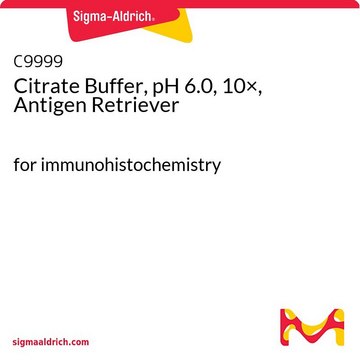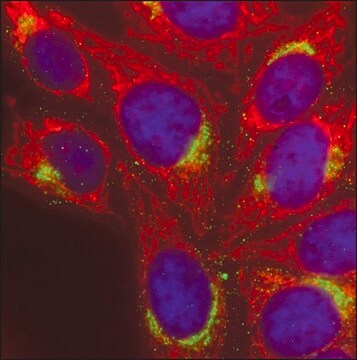AB5896
Anti-P2X3 Receptor Antibody, pain
serum, Chemicon®
Sinônimo(s):
P2X3 Antibody
About This Item
Produtos recomendados
fonte biológica
guinea pig
Nível de qualidade
forma do anticorpo
serum
tipo de produto de anticorpo
primary antibodies
clone
polyclonal
reatividade de espécies
human, rat, mouse
fabricante/nome comercial
Chemicon®
técnica(s)
immunocytochemistry: suitable
immunohistochemistry: suitable
nº de adesão NCBI
nº de adesão UniProt
Condições de expedição
dry ice
modificação pós-traducional do alvo
unmodified
Informações sobre genes
human ... P2RX3(5024)
Especificidade
Imunogênio
Control Peptide: Catalog Number AG356
Aplicação
Immunocytochemistry: 1:1,000.
Optimal working dilutions must be determined by end user.
APPLICATION NOTES FOR AB5896
IMMUNOHISTOCHEMISTRY
Male Sprague-Dawley rats (b.wt. 100-150g) were anesthetized with sodium pentobarbital and perfused via the ascending aorta with: 1) 50 mL of Ca2+-free Tyrode+s solution followed by 2) a formalin-picric acid fixative (4% paraformaldehyde with 0.4% picric acid in 0.16 M phosphate buffer, pH 6.9) and 3) 10% sucrose in PBS as a cryo-protectant. Tissues were rapidly dissected out and stored overnight in 0.1 M phosphate buffer (pH 7.4) containing 10% sucrose. Slide-mounted tissue sections were incubated with blocking buffer for 1 hour at room temperature. Primary antibody was diluted in blocking buffer to the appropriate working dilution. Blocking buffer was removed and the slides were then incubated at 2-8°C for 18-24 hours with AB5896 (1:1,000). After rinsing in PBS 3 times sections were incubated for 60 minutes at room temperature with Cy3-conjugated secondary antibodies. After mounting in a mixture of PBS and glycerol (1:3) containing 0.1% p-phenylenediamine, sections were examined with a Nikon Microphot-SA epifluorescence microscope.
IMMUNOCYTOCHEMISTRYP
2X3 transfected cells were processed for indirect immunofluorescence. Media was removed and cells were gently washed 3 times with serum-free media. Following fixation procedure, cells were processed for indirect immunofluorescence as above.
Neuroscience
Neurotransmitters & Receptors
Neuroinflammation & Pain
forma física
Armazenamento e estabilidade
Informações legais
Exoneração de responsabilidade
Não está encontrando o produto certo?
Experimente o nosso Ferramenta de seleção de produtos.
Código de classe de armazenamento
10 - Combustible liquids
Classe de risco de água (WGK)
WGK 1
Certificados de análise (COA)
Busque Certificados de análise (COA) digitando o Número do Lote do produto. Os números de lote e remessa podem ser encontrados no rótulo de um produto após a palavra “Lot” ou “Batch”.
Já possui este produto?
Encontre a documentação dos produtos que você adquiriu recentemente na biblioteca de documentos.
Nossa equipe de cientistas tem experiência em todas as áreas de pesquisa, incluindo Life Sciences, ciência de materiais, síntese química, cromatografia, química analítica e muitas outras.
Entre em contato com a assistência técnica







